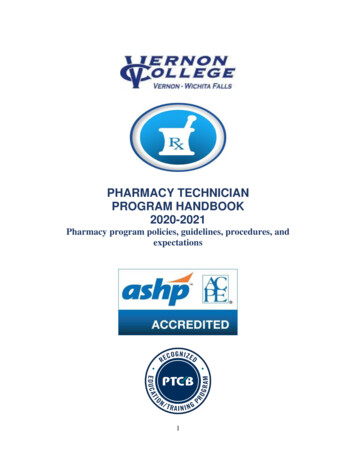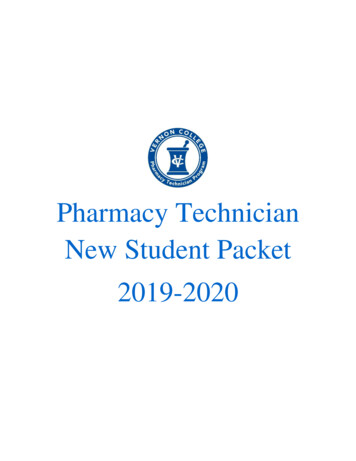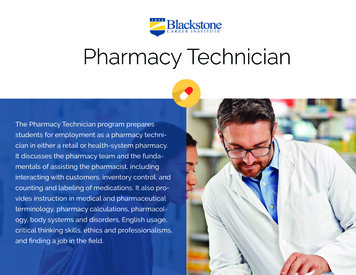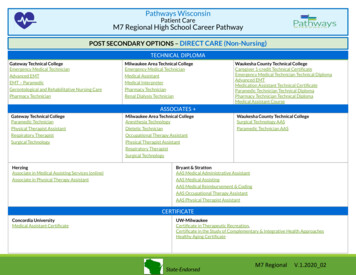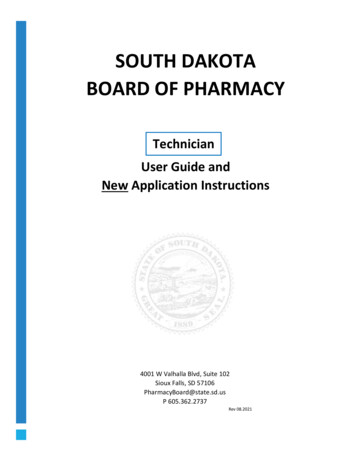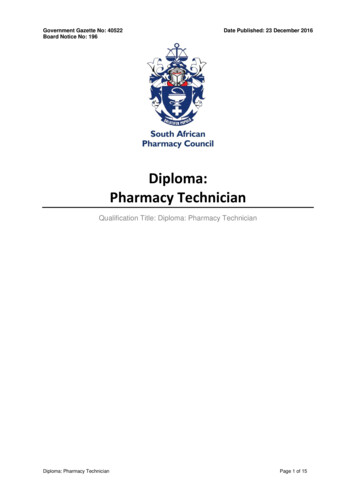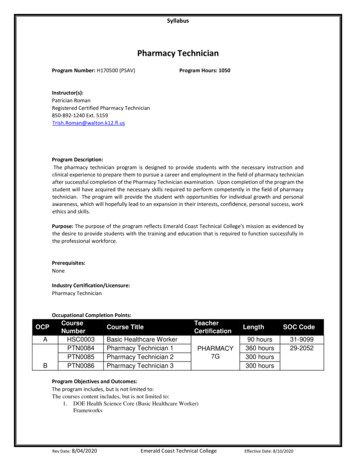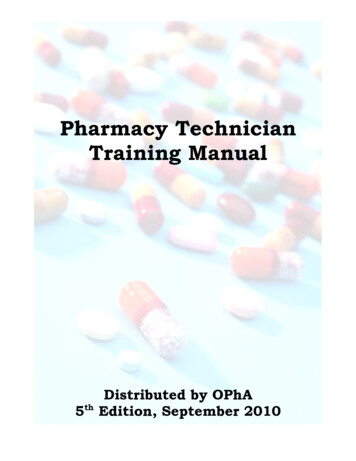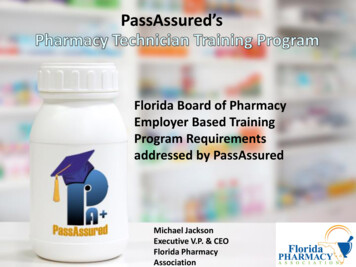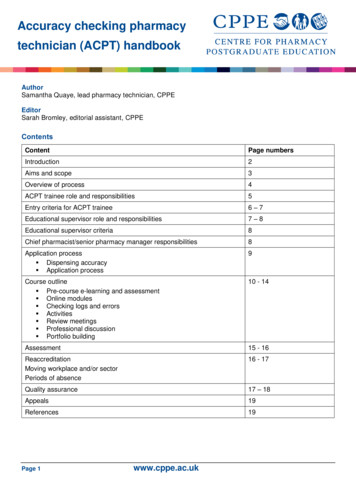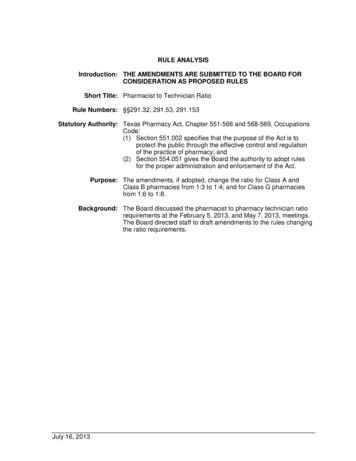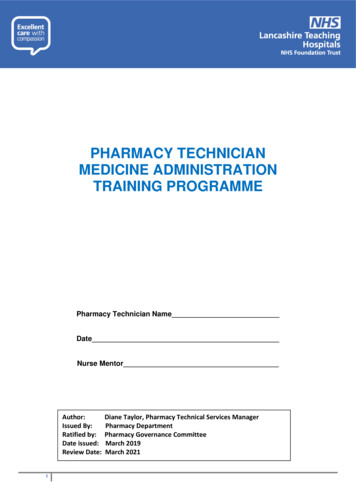
Transcription
PHARMACY TECHNICIANMEDICINE ADMINISTRATIONTRAINING PROGRAMMEPharmacy Technician NameDateNurse MentorAuthor:Issued By:Ratified by:Date issued:Review Date:Version: 11Diane Taylor, Pharmacy Technical Services ManagerPharmacy DepartmentPharmacy Governance CommitteeMarch 2019March 2021
1.INTRODUCTION1.1Instructions for Completion of this Self-Directed Package:This learning package is designed to assist you in learning the theoretical knowledgeyou need to administer medication.To complete your administration of medicines training you will need a nurse mentor toassess your competency throughout the programme. Your nurse mentor/ assessor willbe a registered nurse who has completed preceptorship, has a Learning and Assessingqualification and is up to date with current medicines administration competenciesYou will need to complete all the sections of the package and be fully sign off by NurseMentor and Pharmacy Mentor, to include: Nurse Mentor Checklist for Medicines Administration Pharmacy Technicians(Appendix 1) Medicines Administration Training Programme 200 item pre- assessment administration log (Appendix 2) Shadowing medication rounds with the nurse administering medication andspecialist nurse with the completion of 10 reflective statements (Appendix 3) ONE month continuous item assessment administration logADMINISTRATION OBSERVATION AND ASSESSMENT (Appendix 4) 200 item post assessment administration log (Appendix 5) Final review (Appendix 6)PLUSEach section begins by stating a set of intended learning outcomes, these will help you toassess your level of understanding and identify any deficits in your knowledge.1.2 Reading ListLTHTR General Medicines PolicyLTHTR Controlled Drugs Policy and ProcedureLTHTR Medicine Administration by Oral and Enteral Routes Clinical GuidelineLTHTR Self-Administration of Medicines ProcedureMedicines Management Power Point PresentationMedicinesmanagement Introduction for MAPT.pptx2
1.3 Scope of PracticePharmacy Technicians ARE PERMITTED TO ADMINISTER the following medication typesOral MedicationEye MedicationNasal MedicationInhaled MedicationNebulised MedicationsTopical MedicationsTransdermal MedicationsPharmacy Technicians are NOT PERMITTED to administer any of the following patient ormediation typesPatients with swallowing difficultiesPatients requiring medicines administered via enteral tubeAll injection typesRectal medicationVaginal Medication3
2. LEGAL FRAMEWORK AND ACCOUNTABILITY2.1Legal and Accountability IssuesOn completion of this section you will be able to:Define negligence and understand what components must be proven before a claim ofnegligence can be upheldUnderstand the contractual accountability of an employer and define vicarious liabilityDefine accountability and how it applies to the pharmacy technician roleUnderstand the professional responsibilities of the Pharmacy Technician in relation toadministration of medicines2.2NegligencePharmacy Technicians have a professional obligation to act in the best interest of their patients.Where individuals deviate from this duty of care and cause actual harm, a patient orrelative can sue for negligence.For this action to be successful there is a requirement for three conditions to be satisfied: The professional was under a duty of care to the individual That a breach in the duty of care has occurred That as a result of this breach, harm has been caused to the patient be it physical,financial or psychological.(Scales 2009)The Pharmacy Technician, when accepting a patient allocation, ha s a le g a l ob lig a t io n t op r o v i d e adequate care of an acceptable standard. If the care to be provided falls outsidethe Pharmacy Technicians knowledge and skills he/she should therefore decline the allocation.If this duty of care is breached then the next step will be to prove liability.A breach is measured by what is known as the Bolam test 'The standard that an ordinary skilledman exercising and professing to have that special skill' (BFHMC 1957). This means that aPharmacy Technician will have to provide a standard of care as demonstrated by anotherPharmacy Technician with the same experience and qualifications.4
2.3LiabilityWith regard to negligence employers have two forms of liability:Direct liability: this is where they are at fault for example when a drug error has been madebecause the hospital has not withdrawn faulty infusion pumps.Vicarious liability: this is where they are responsible for the actions of their employees duringthe course of their employment. For example, an employer will accept responsibility if you haveacted within your code of professional conduct and within employers policies and procedures,to a level of expertise that reflects experience and training.The important thing to note about liability is that if the pharmacy technicians practice fallsoutside of hospital policy, he/she then loses the protection of vicarious liability. Should apharmacy technician experience conflict between policies and practice, there is clearly aprofessional responsibility to resolve the conflict.2.4AccountabilityAccountability is defined as "Expected to explain ones actions or decisions" (Oxford EnglishDictionary 2002).As a Pharmacy Technician you have three main areas of accountability:1. Accountable to the Public via Criminal Law:This law would come in to force when an individual was deemed to have committed a crimeagainst the state, for example, the theft and subsequent sale of controlled drugs.Manslaughter prosecutions will also be tried under criminal law.Accountable to the Individual via Civil Law:This law would come in to force when a private individual or his/her relative takes legalaction against a pharmacy technician if negligence is implicated in the injury or death. Civillaw would seek to establish accountability and award damages.Accountable to the Employer via a Contract of Employment:Disciplinary procedures will come into force when an employer proves that an employmentcontract has been broken. An employment contract assumes that employees will complywith terms and conditions both implicit and explicit. Failure to comply could result indisciplinary action against an employee.5
Set task:Look at your contract of employment and write down what it says about yourresponsibilities to provide quality care.2.5Responsibility and Accountability in Relation to the Administration of Medicine by aPharmacy TechnicianFor pharmacy technicians administration of medication are personally accountable for theirpractice and are answerable for any acts and omissions and have a legal duty of care to theindividual to only engage in practice he/she has been trained and deemed competent toundertake, and is accountable for any actions or errors he/she makes.6
3.DRUG CALCULATIONSOn completion of this section the pharmacy technician will be able to:Understand their responsibility in calculating drug dosage.Perform simple arithmetical tasks.Accurately calculate drug dosages using an accepted formula.Although medical practitioners and non-medical prescribers are legally responsible for the correctprescription of a medication, the person administering the dose is accountable for checking thatthe dose of the medication is correct for the patient's weight according to accepted prescriptionguidelines, and also for ensuring the correct calculated dose is given.The RPS RCN Professional Guidance on the Administration of Medicines in Healthcare Settings(January 2019) states:‘any calculations needed are double checked where practicable by a second person anduncertainties raised with the prescriber or a pharmacy professional’3.1mg/kg calculationsSome doses of medication are calculated on a mg/kg basis. The prescriber will calculate the doseand prescribe accordingly. Pharmacy technicians must check the prescribed dose as part of theadministration process.e.g.The dose required is 4mg/kg. The patient weighs 50kg.i.e. the patient needs 4mg of medicine for every kg body weight.So the dose needed is 4mg x 50 200mg.The British National Formulary (BNF) should be consulted to check doses.N.B. Sometimes a maximum dose is stated as well as mg/kg.e.g.prednisolone is recommended as 2mg/kg BUT maximum daily dose of 40mg.Therefore for 46kg - the dose recommended at 2mg/kg 92mg however 40mg is given as therecommended maximum daily dose.Remember!1 gram (g) 1000 milligrams (mg)1 milligram (mg) 1000 micrograms1 microgram 71000 nanograms
Complete the following table: -Recommended DosePatients Body kg42.1kgDose required3.2 Further CalculationsA patient is prescribed 8mg of Furosemide. Calculate how many millilitres you would administer foreach dose using the 40mg in 5ml oral solution.A patient is prescribed 6mg of Furosemide. Calculate how many millilitres you would administer foreach dose using the 40mg in 5ml oral solution.A patient is prescribed 150mg of Paracetamol. Calculate how many millilitres you would administerfor each dose using the 120mg in 5ml oral solution.A patient is prescribed 125mcg of Digoxin originally as tablet form; however this has beenamended to liquid. What dose of liquid medication would you administer?A patient is prescribed 10mg of Citalopram. Calculate how much liquid you would need for eachdose.A patient is prescribed 200mg of Phenytoin. Calculate how much liquid you would administer foreach dose.You have Morphine oral solution 10mg in 5ml. The patient requires a dose of 2.5mg. Whatvolume of solution would you give?Alfacalcidol drops are presented as 100 nanograms per drop. A dose of 0.5 micrograms isprescribed. How many drops would you administer?8
A patient requires a 2.4g dose of Co-trimoxazole (Septrin) in an oral liquid form. The adultsuspension presentation is 480mg in 5ml. What volume should be administered?Sodium Valproate is available as a 200mg in 5ml oral liquid. How many millilitres would berequired to give a dose of:500mg800mgYou have Erythromycin suspension which contains 250mg in 5ml. How many milligrams ofErythromycin are there in:2.5ml8ml3.3 HEE Introduction to Medicines Calculations WorkbookComplete the workbook.MedicinesCalculations Workbook April 2018.pdf9
4. PRINCIPLES OF MEDICINE ADMINISTRATIONThese principles apply to all practitioners who administer medication.On completion of this section the pharmacy technician will be able to:Understand how to manage the risks associated with medicine administration.Be familiar with the format of in-patient prescription charts.Understand how to administer medications via different routes.Pharmacy technicians who administer medication must have completed appropriate training andhave been deemed competent by a registered nurse.Good medicines management is essential to assure high standards in the clinical area ofpatients. When delivered effectively, it can reduce the risk of medication errors andserious adverse drug reactions and prevent unnecessary delays for the patient atdischarge. Administration is not just about complying with the written directions of theprescriber; it is a process that requires the exercise of professional judgement. Alldirections to administer a medication should be checked by the professional applying theirknowledge of the medicine to be administered.4.1 The 5R’s of Medicines AdministrationThe medicines administration process has a 5R’s systemic approach which ensures essentialsafety checks are in place to protect against medication errors.Write below the 5 rights of medication administration and explain how adherence to each processprotects the patient.RIGHTRIGHTRIGHTRIGHTRIGHTAre there any other steps in medication administration that could be expandedupon to ensure patient safety is maintained?10
4.2 Prescription Chart Workshop/EPMA trainingComplete the following prescription chart workshop with your pharmacy mentorPrescription chartworkshop 10.17.pptxComplete the EPMA medicines administration training pack4.3 Complete the following Trust e-learning packages: Safe Use of InsulinAntibiotic StewardshipVTEAdvice for Alcohol and Smoking4.4 AllergiesAt what stage/s should allergy status be confirmed?If you are made aware of an undocumented allergy what actions would you take?What is anaphylaxis?Write down the signs and symptoms of anaphylaxisWhat action would you take if you suspected a patient was experiencing an anaphylacticreaction?11
4.5 Medication Errors/OmissionsThe pharmacy technician must make a clear, accurate and immediate record of all medicineadministered, intentionally withheld or refused by the patient.Give examples below of any omitted medications when observing medication rounds and detailsof the reason and potential effect on the patient in missing their dose.Medication omittedReasonPotential effect on patientcare.What would you do if you administered a medication incorrectly?What action would you take if you purposefully omitted a medication e.g. paracetamol aspatient was not in pain.What action should you take if a patient refuses their medication?12
4.6 Self-Administration of MedicinesRead and discuss the Self Administration of Medicines Policy SAM’s with your mentorWhich medicine can a patient self-administer without the need to complete a SelfAdministration consent form?Which staff members are authorised to complete a consent form with a patient?When and by whom should the self-administration consent form agreement be reviewed?Describe the process for a patient who self-administers their medicationComplete a self-administration consent form with a patient under observation of yourmentorDate Completed:13Mentor Signature:
4.7 Administering MedicationWhen administering medication the pharmacy technician must: know the therapeutic use of the medicine to be administered,be efficient at calculating the recommended dose,check the prescribed dose against the recommended dosehave an awareness of the contra-indications and side effects(information that can be accessed using the BNF - latest version)The Pharmacy Technician must be aware of how the particular medication contributes tomanaging the patient’s signs and symptoms.In the table below collect evidence from your observed practice that you have soughtinformation in relation to the factors discussed. Your observed practice log book will show yourinvolvement in administering a greater range of medications.Drug NameReasonfor RxPrescribeddoseRecommendedDoseSide EffectsDesired EffectContraindicationsThe pharmacy technician must be certain of the identity of the person for whom the medicine isprescribed.In the table below state different ways you can confirm the identity of a patient:14
The pharmacy technician must check that the prescription and label on the medication are clearlywritten according to agreed guidelines. In the event of any discrepancies note if you brought this tothe attention of medical staff/ prescriber.Record any events regarding poor prescribing procedure:BlackInk?Legible? Signed?Correct Duration ofdose units? courseMedical staffinformed?OutcomeThe Pharmacy Technician must check the expiry date of the medication.N.B. Some medicines have a long expiry but must be discarded at a determined period afteropening. Other drugs will be re-constituted from dry powder in the ward area. Those drugs willhave a manufacturer’s expiry and an expiry from the date of re- constitution.How would you dispose of any medication that had either passed its expiry date or was no longerrequired?15
State the drug, the method of disposal and why this method was chosen.Drug NameMethod of disposalRationaleThe Pharmacy Technician must report any adverse events to a member of the medical team andto the manager.State below the types of adverse events that may justify a clinical incident report16
4.8 High Risk and Critical MedicinesLocate and print a copy of the Critical medication list for the TrustWhat is a critical medicine and what are the standards expected for critical medicineadministration?State the different categories of Critical Medicines at LTHTRWhat information should be checked before administering Warfarin?Name any other oral anticoagulant you are aware of used in this TrustWhat types of observations should be carried out if a patient is taking an anticoagulant?What advice would you give them upon discharge regarding their medication?Methotrexate is a high risk medication which must have a consultant signaturedocumented on the prescription chart. It is a ONCE A WEEK medication.What is the potential harm of administering this medication incorrectly?17
4.9 When to Omit a Medication?Before beginning to administer patient medication the pharmacy technician must confirm on theQMED system under the VITAL SIGNS tab that all of their patient’s blood pressure, respirationand pulse are in normal range.This is a second check to enable the pharmacy technician to identify any out of range parameterswhich would affect the administration of a certain type of medicatione.g. Anti –hypertensives, cardiac medication, opiates, benzodiazepines and diabetic medicationEqually it is important to confirm blood results on the QMED system to ensure no electrolytes areabove critical range this includes potassium, magnesium, phosphate and calciumWhat medication would you confirm with the nurse when electrolyte parameters are critical beforeomitting the medication?PotassiumMagnesiumPhosphateCalciumIt is the responsibility of the individual nurse in charge of each patient to endorse the prescriptionchart with a 6 for any medication which is to be omitted. The above process is a second check bythe Pharmacy Technician to ensure correct medication administration protocol is followed. Shouldthe Pharmacy Technician identify any anomalies with vital signs and blood results were the nursehas failed to endorse the prescription chart with a 6 this should be documented on the PharmacyTechnician Hand over document (Appendix 7) and referred back to the nurse for clarification.18
5. MEDICINES ADMINISTRATION COMPETENCYThe Safe Administration of Medications Competency must be completed for the followingmedication types:Oral MedicationEye MedicationNasal MedicationInhaled MedicationNebulised MedicationsTopical MedicationsTransdermal MedicationsThis Trust document stipulates the standards which must be achieved for each type of medicationto ensure correct medicine administration protocol is followed.The Trust core competencies must also be completed prior to each administrationthese include: Washes hands with bactericidal soap and water or bactericidal alcohol hand rub.Checks and prepares trolley with standard equipment – e.g. Keys, medicine pots, BNFavailable sharps box, stock etc.(EMPA) - Ensures trolley has been on charge and has battery life once unplugged.Verifies that the prescription chart/screen is the correct one for the patient both visually andverbally, (EMPA) Scan name banda. Nameb. Date of Birthc. Unique identification numberIf using more than one paper chart - checks details are correct on every chart/record sheet.Checks the patient’s allergy status is record and makes every effort to verify it is correct.Documents any changes in allergy status immediately.Verifies the validity of the prescriptions and reviews for any potential previouslyunrecognised allergens.Paper – Reviews the whole of the chart.EMAR Open the 7 day summary:a. Drugb. Dosec. Date and time of administrationd. Route and method of administratione. Specific Instructionsf. Signature of prescriber (Paper)g. The prescription is legible (Paper)Takes action to address any concerns or issues with the prescription before preparing toadminister the medication.Utilises the BNF as necessary to gain information about the medication, including normaldose range, side effects and contraindications.Notes any medications deemed as Critical Medicines.19
Before beginning a medicines administration round it is important to identify from the handovermeeting any patients who require any CRITICAL medication to be administered as priority beforebeginning the routine administration round.6. REFERENCESRPS RCN Professional Guidance on the Administration of Medicines in Healthcare Settings (Jan2019)LTHTR The Medicines Management (General) Policy 3.1LTHTR Medication Administration Workbook7. ACKNOWLEDGEMENTSVickie Rose, Chief Pharmacy Technician, University Hospitals Morecambe Bay.20
Appendix 1NURSE MENTORS CHECKLIST FOR MEDICINES ADMISTRATION PHARMACY TECHNICIANSAreas to coverIntroductions to team and explanation ofroles:Ward ManagerClinical LeadersStaff NursesClinical Support WorkersWard ClerkAdmin AssistantHousekeeperDischarge Co-ordinatorMedical Team – Team BasedPhysiotherapistsOccupational TherapistsExtended MDT who visit the wardHandover Terminology ExplanationObservations Rationale i.e. BP, respiration, pulseBM recordings prior to administration ofGliclazide/MetforminTheatre Patients – starving regimes – Nil bymouth21DatecompletedComments
Prep. For investigations i.e. endoscopy, radiologyList of commonly used abbreviationsInformation re IV drug usersBarrier room procedures – PPE useNutritional DrinksFeeding RegimesEnteral syringe useFluid balance ChartsPalliative Care TeamMedicationStock top up day –Transfer of Medication between wardsMaintaining adequate stock levelsScenariosHow to deal with Administering medication topatients with DementiaWhen patients ask staff to leave the medicationfor them to take on their ownUseful TipsAlendronic acid – give on empty stomach 30minutes before breakfastNurse Mentor Signature DateMedicines Administration Pharmacy Technician Name Date22
Appendix 2Medicine Administration Pre Log (200 items)Name:No:DateDrug/Dose/FormErrors/Issues rd of Any Issues or Errors23Trainees SignatureCheckers Signature
Date24Details of Errors/IssuesTrainee CommentsChecker Comments
Medicine Administration Pre Log (200 44454647484950Date25Drug/Dose/FormErrors/Issues foundTrainees SignatureCheckers Signature
Medicine Administration Pre Log (200 69707172737475Date26Drug/Dose/FormErrors/Issues foundTrainees SignatureCheckers Signature
Medicine Administration Pre Log (200 949596979899100Date27Drug/Dose/FormErrors/Issues foundTrainees SignatureCheckers Signature
Medicine Administration Pre Log (200 Dose/FormErrors/Issues foundTrainees SignatureCheckers Signature
Medicine Administration Pre Log (200 Dose/FormErrors/Issues foundTrainees SignatureCheckers Signature
Medicine Administration Pre Log (200 Dose/FormErrors/Issues foundTrainees SignatureCheckers Signature
Medicine Administration Pre Log (200 Dose/FormErrors/Issues foundTrainees SignatureCheckers Signature
Appendix 3REFLECTIONS ON LEARNING AND PRACTICEDate. . . . . . . . . . . . . . . . . . . . . . . . . . .32
Appendix 4Medicine Administration Log (1 Month Continuous Observation Assessment)(Approx. 1000 12223242533Drug/Dose/FormErrors/Issues foundTrainees SignatureCheckers Signature
Record of Any Issues or ErrorsDateAppendix 534Details of Errors/IssuesTrainee CommentsChecker Comments
Medicine Administration Pre Log (200 32425DateDrug/Dose/FormErrors/Issues foundRecord of Any Issues or Errors35Trainees SignatureCheckers Signature
Date36Details of Errors/IssuesTrainee CommentsChecker Comments
Appendix 6PHARMACY TECHNICIAN MEDICINES ADMINISTRATION - FINAL ASSESSMENTDISCUSSIONTo be completed by a Senior Nursing Representative and the Trust Pharmacy Deputy TechnicalServive Manager for pharmacy technicians completing medicines administration training.We . (Senior Nursing Representative)and Diane Taylor (Pharmacy Technical Service Manager)declare that .(Medicines Administration Pharmacy Technician)has completed the Medicines Administration Training Programme and can confirm that they arecompetent in the administration of medication.The following action has been taken to ensure their competenceACTIVITYCompletion of Medication AdministrationTraining Programme workbookNurse Mentor checklist informationWard round training with mentor(s)Shadowing of Respiratory Nurse SpecialistsCompletion of 200 item pre logCompletion of 1 months continuousobserved competency assessment logCompletion of 200 item post logCompletion of The Safe Administration ofMedications Competency to includeOral MedicationEye MedicationNasal MedicationInhaled MedicationNebulised MedicationsTopical MedicationsTransdermal MedicationsCOMPLETEDWe agree that all appropriate measures are in place to demonstrate competance in this role andensure best practice within the work place.Trust/Organisation NameLancashire Teaching Hospitals NHS Foundation TrustSenior Nursing Representative Signature Print Name:Deputy Technical Service ManagerSignaturePrint Name:Trainee SignaturePrint Name:Date:37
Appendix 7PHARMACY TECHNICIAN MEDICATION ADMINISTRATION HANDOVER DOCUMENTBed numberPatient NameVital Signs/Blood result anomalies12345678938NURSE HANDOVER TO PTMAEg nil by mouth/necessary medicationomissions/self-medicating ts/abnormal NEWS/BPPTMA HANDOVER TO NURSEE.g. Medication refused by patient,Omission not documented for confirmationPTMA HANDOVER TO DOCTOREg Medication requiring prescribing,Chart re-write required, antibiotics forreview
The pharmacy technician must make a clear, accurate and immediate record of all medicine administered, intentionally withheld or refused by the patient. Give examples below of any omitted
